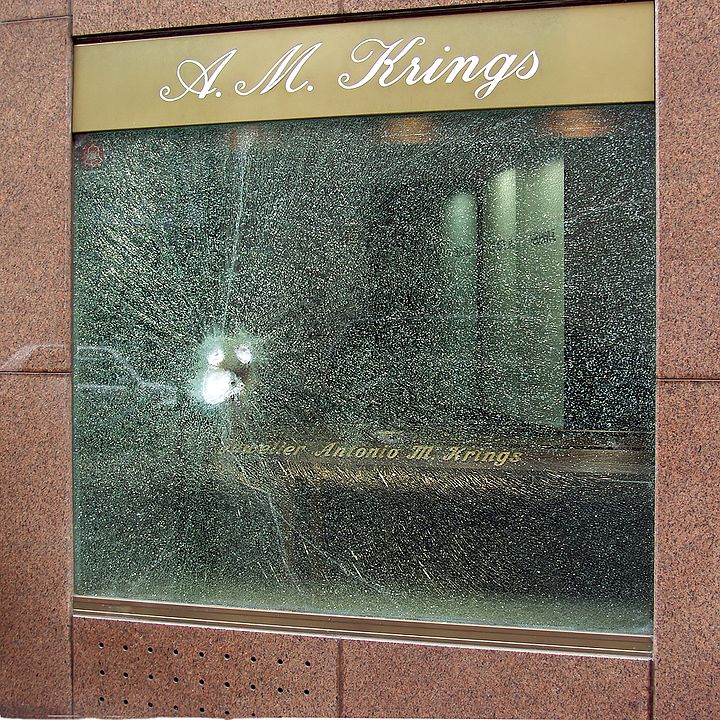
I learned this today. Bulletproof glass is made of two different types of laminated glass, one hard and one soft.
Glass was invented in about 2500 BC, although only used as beads and jewelry. In 1450 BC, Egyptians started using glass drinking vessels. Plate glass was invented in about 1620 and glass production was industrialized by 1800. This was all regular glass and it shattered fairly easily.
Unbreakable glass was apparently first discovered in Rome, but there is no real evidence for that. There is a story that a glass maker invented flexible glass (vitrum flexile) and made a bowl of it which he presented to the emperor Tiberius Caesar. When it was dropped, the bowl dented, and the maker fixed it with a hammer. There doesn’t appear to be any more evidence than this.
To make glass stronger, Francois Barthelemy Alfred Royer de la Bastie invented tempered glass in 1874. It is sometimes called Bastie glass after him. He quenched molten glass in a heated bath of oil or grease. The process was improved in 1877 when Friedrich Siemens started pressing the tempered glass in cool molds. It is stronger because the outside of the glass cools before the inside and puts it under tension. That is also why it crumbles rather than shatters when broken.
Modern car windows and house windows are made of tempered glass. It is a safety glass that can withstand temperature changes, is four times stronger than regular glass, and when it is broken it breaks into small, rounded chunks, rather than shards of regular glass. However, tempered glass wouldn’t stop a bullet.
In 1903, Edouard Benedictus, a French chemist, dropped a glass flask with a liquid nitrate solution in it on the floor. The glass broke but did not shatter. The liquid nitrate inside the flask had coated the inside of the glass flask with a thin layer of plastic. He had basically invented laminated glass. He patented it the very same year.
This laminated glass was the very first bulletproof glass and it saw use on the battlefields of World War 1. It was also used in gas masks.
Layers of laminated glass were used as bulletproof glass from here on, and in World War 2, they were used in military vehicles to protect troops. Making it was far too expensive for most vehicles or people, so it was mainly used by criminals and the rich. A lot of banks and casinos started to use it to protect their buildings.
The Mona Lisa was put behind bulletproof glass in 1956 and the popemobile was outfitted with bulletproof glass in 1981, to protect Pope John Paul II.
So, how does bulletproof glass work? When regular glass is shot, the bullet hits the glass and the glass has no flexibility, so it fractures from the point where the bullet pierces it. The glass doesn’t remove much of the bullet’s energy, so the bullet carries straight on.
Bulletproof glass works by having layers of plastic to absorb the bullet’s energy. There is usually a sheet of safety glass followed by a layer of polycarbonate, which is a very strong, transparent plastic. Then there will be more layers of glass and polycarbonate. When a bullet hits the outer layer of glass, the glass is hard and deforms the bullet. The glass breaks and the bullet then hits the next polycarbonate layer and its energy is spread out sideways, over a large surface area, and through the other layers. This reduces the bullet’s energy to zero and stops it. The energy is changed to heat and the bullet can actually melt into the window.
However, bulletproof glass only works if it is thick enough to stop the energy in a bullet. Lower caliber guns obviously impart less energy to their bullets than high caliber guns. If a bullet has more energy than the bulletproof window’s layers can absorb, it will just carry straight on through. For this reason, bulletproof glass is rated from level 1 to 10. Level 1 will stop 3 shots fired from a 9mm gun and level 10 will stop one shot fired from a Browning machine gun. That is amazing, but no machine gun fires only one shot, so I’m not sure what its purpose is. Maybe for a vehicle that is fleeing.
There have been several advances in bulletproof glass since its invention. The US military started using aluminium oxynitride instead of the regular laminated glass. This is basically transparent aluminium, and it is up to three times stronger so you can get more protection for less weight. The problem with any armoring is its weight. Transparent ceramics are also being used. They are much lighter and much stronger than glass.
Bulletproof glass gets stronger and lighter every few years, but it is probably better to call it “bullet resistant glass” because no glass can ever be completely bulletproof. If you shoot it enough times, or with a more powerful gun, it is going to break in the end.
So, bulletproof glass works by removing the bullet’s forward momentum by absorbing its energy. And this is what I learned today.
Image By © Raimond Spekking / CC BY-SA 4.0 (via Wikimedia Commons), CC BY-SA 4.0, https://commons.wikimedia.org/w/index.php?curid=4547497
Sources:
https://en.wikipedia.org/wiki/Tempered_glass
https://www.explainthatstuff.com/bulletproofglass.html
https://science.howstuffworks.com/question476.htm
https://www.silatec-bulletproofglass.com/how-does-bulletproof-glass-work/
https://en.wikipedia.org/wiki/Bulletproof_glass
https://en.wikipedia.org/wiki/History_of_glass
